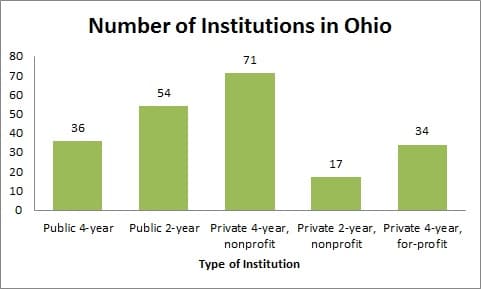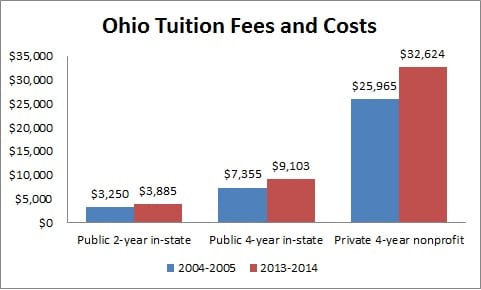Education in Ohio
The state of Ohio was home to more than 11.5 million residents in 2013, according to 2013 estimates from the U.S. Census. However, only 24.7 percent of Ohio’s working age adults held a Bachelor’s degree from 2008-2012. A recent report from the Lumina Foundation offers more clarity to the issue of overall educational attainment in Ohio as well. According to the Lumina Foundation, approximately 35.5 percent of the state’s working age adults (25-64) held at least an Associate’s degree in 2011 and an additional 22.42 percent had some college experience but no degree.
The National Center for Educational Statistics (NCES) posted the following numbers for the total amount of universities in Ohio:
- Public 4-year institutions: 36
- Public 2-year institutions: 54
- Private 4-year nonprofits: 71
- Private 2-year nonprofits: 17
- Private 4-year for-profit: 34

Although degree-seeking adults are in the minority in Ohio, statistics prove that educational attainment is on the rise in the state. Fortunately, there are plenty of colleges and universities in Ohio for students to choose from. The NCES reports that there are currently 166 schools where students can earn an Associate’s degree in Ohio, in addition to 116 institutions that offer Bachelor’s degrees. Furthermore, the NCES data found colleges and universities in Ohio awarded 112,238 four-degrees and 42,741 two-year degrees during the 2011-2012 school year.
Online education in Ohio
Due to family obligations and the need for many students to continue working while they pursue higher education, many students in Ohio have opted to pursue a flexible, online or hybrid degree. Online options have become popular in recent years as a way for non-traditional students to gain credentials while continuing to work or fulfill other responsibilities.
Students can find plenty of colleges and universities in Ohio that offer these programs. In fact, many of the largest schools in the state offer online or hybrid courses and degree programs – schools like Ohio University, University of Northwestern Ohio, and even Notre Dame. The state is also home to OhioLearns, a one-stop shop for anyone interested in pursuing online higher education within the state. Interested students can use the OhioLearns database to learn more about online degree programs that are available in the state and compare them.
Here are some of the standout online schools in Ohio as ranked by U.S. News and World Report:
- Ohio State University–Columbus
- Best Online Bachelor’s Programs #8
- Best Online Graduate Engineering Programs #19
- Best Online Graduate Nursing Programs #6
- Tiffin University
- Best Online Graduate Criminal Justice Programs #6
Top careers in Ohio
With big cities like Cincinnati, Columbus and Cleveland within the state’s borders it’s easy to see why Ohio would be home to so many of the nation’s largest industries. However, there are plenty of rural spaces in Ohio as well, and those regions are also home to their fair share of jobs.
If you’re looking for top careers in Ohio for college graduates, you’ve come to the right place. By combining employment projections from the Department of Labor’s CareerOneStop with wage reports from the Bureau of Labor Statistics, we’ve created this list of top careers in Ohio:
| Occupation | Top regions | Projected 2012-2022 job growth | Necessary skills* | Relevant degrees |
|---|---|---|---|---|
| Interpreters and translators | Although interpreters and translators currently work all over the state of Ohio, many of them are clustered in the following regions: Columbus (890), Cincinnati-Middletown (190), and Dayton (150). | Department of Labor figures show that employment for interpreters and translators in Ohio will increase 48 percent during the decade leading up to 2022. | Interpreters and translators typically need interpersonal skills and cultural sensitivity in order to excel in their career. | The BLS reports that most interpreters and translators need a Bachelor’s degree in order to gain employment, although the most important requirement is fluency in at least two languages. Therefore, a common path for this career is earning a Bachelor’s degree in English or a foreign language. |
| Diagnostic medical sonographer | However, most of the state’s diagnostic medical sonographers work in the following regions: Cincinnati-Middletown (340), Columbus (280), and Southern Ohio nonmetropolitan area (100). | According to the U.S. Department of Labor, employment for diagnostic medical sonographers is expected to increase 39 percent in Ohio from 2012 to 2022. | Since diagnostic medical sonographers are in charge of taking ultrasounds of patients who are ill or injured, they need to have the proper technical skills to do the job as well as physical stamina, attention to deal, and good interpersonal skills. | The BLS reports that diagnostic medical sonographers typically need an Associate’s degree or postsecondary certificate in order to practice in the profession. However, some students also enter this career with a Bachelor’s degree in radiologic science or cardiovascular and vascular technology. |
| Occupational therapy assistant | Most occupational therapy assistants worked in the following areas of Ohio: Cincinnati-Middletown (420), Cleveland-Elyria-Mentor (320), and Columbus (230). | Due to a growing demand for health care service of all kinds, the U.S. Department of Labor predicts that employment for occupational therapy assistants in Ohio could increase as much as 36 percent from 2012 to 2022. | Since occupational therapy assistants work with the public and aid in rehabilitation, they need good communication skills and a positive bedside manner. Compassion, physical strength, and flexibility are also good traits to have. | The BLS reports occupational therapy assistants need to earn an Associate’s degree from an accredited institution before pursuing employment. These type of programs are typically found in community colleges and technical schools. |
| Meeting, convention and event planners | Although meeting, convention, and event planners are spread throughout the state, most of them work near the larger cities: Columbus (540), Cleveland-Elyria-Mentor (470), and Cincinnati-Middletown (450). | The U.S. Department of Labor predicts that employment for meeting, convention, and event planners could increase as much as 31 percent from 2012 to 2022. | Because meeting, convention, and event planners deal with many details and moving parts, some of the most important qualities for these professionals to have are interpersonal skills, negotiation skills, and organizational skills. | According to the Bureau of Labor Statistics, many employers in this field prefer to hire candidates with a Bachelor’s degree in hospitality management or a related field. However, individuals with a degree in another field can often gain employment after competing at least 1-2 years of on-the-job training or experience. |
| Information security analysts | Although meeting, convention, and event planners are spread throughout the state, most of them work near the larger cities: Columbus (540), Cleveland-Elyria-Mentor (470), and Cincinnati-Middletown (450). | The U.S. Department of Labor predicts that employment for these professionals could increase by as much as 29 percent in Ohio from 2012 to 2022. | Beyond educational attainment, information security analysts also need analytical skills, an attention to detail, and ingenuity in order to get the job done well. | The BLS reports that information security analysts typically need a Bachelor’s degree in a computer-related field. Some of the most popular majors to start this career include computer science, computer engineering, and cyber security. |
*Skills breakdowns derived from O*NET OnLine
Ohio financial aid
Tuition and fees for in-state students at public four-year institutions of higher education averaged out to $9,906 for the 2013-14 school year according to College Board Statistics. A review of the College Board’s Trends in Higher Education report produced the following breakdown of average tuition and fees for different types of institution:
- Public two-year institutions
- 2004-2005: $3,250
- 2013-2014: $3,885
- Public four-year institutions
- 2004-2005: $7,355
- 2013-2014: $9,103
- Private four-year nonprofit institutions
- 2004-2005: $25,965
- 2013-2014: $32,624

Fortunately, there are other resources at the disposal of Ohio’s college students, including Ohio financial aid and grants provided by private and government entities. The Ohio Department of Education singles out the following resources:
Federal Grants
- Pell Grants
- Federal Supplemental Educational Opportunity Grant
- TEACH Grants
- Iraq and Afghanistan Service Grants
State Grants and Scholarships
- Choose Ohio First
- Opportunities For Veterans
- John R. Justice Student Loan Repayment Program
- Nurse Education Assistance Loan Program
- Ohio College Opportunity Grant
- Ohio War Orphans Scholarship
- Ohio Safety Officers College Memorial Fund
- Ohio Third Frontier Internship Program
- Forever Buckeyes
Federal Loans
- Federal Direct Loan Programs
- Federal Perkins Loan Program (expired 9/30/17, although Congressional bills have been introduced that support its extension)
- Federal Direct PLUS Loan Program
- Federal Direct Graduate/Professional PLUS Loan Program
Other scholarships and grants may also be available to students seeking out Ohio financial aid. In addition to these programs, several student loan forgiveness programs are also offered in Ohio, although requirements may vary. Make sure to research potential aid before applying for college in order to determine what your overall costs may be.
To find out more about some of the schools and programs available in Ohio, be sure to check out the ones featured in our school listings below.
Sources
- U.S. Bureau of Labor Statistics, Occupational Employment and Wages: “Interpreters and Translators,” May 2013 http://www.bls.gov/OES/current/oes273091; “Meeting, Convention, and Event Planners,” May 2013, http://www.bls.gov/oes/current/oes131121; “Information Security Analysts,” May 2013, http://www.bls.gov/OES/current/oes151122; “Occupational Therapy Assistants,” May 2013, http://www.bls.gov/oes/CURRENT/oes312011; “Diagnostic Medical Sonographers,” May 2013, http://www.bls.gov/oes/CURRENT/oes292032; “Interpreters and Translators,” May 2013, http://www.bls.gov/ooh/media-and-communication/interpreters-and-translators
- U.S. Bureau of Labor Statistics, Occupational Outlook Handbook 2014-15 Edition: “Information Security Analysts,” December 29, 2014, http://www.bls.gov/ooh/computer-and-information-technology/information-security-analysts#tab-1; “Diagnostic Medical Sonographers,” December 29, 2014, http://www.bls.gov/ooh/healthcare/diagnostic-medical-sonographers#tab-1; “Meeting, Convention, and Event Planners,” December 29, 2014, http://www.bls.gov/ooh/business-and-financial/meeting-convention-and-event-planners#tab-1; “Occupational Therapy Assistants and Aides,” December 29, 2014, occupational-therapy-assistants-and-aides
- “A Stronger Nation through Higher Education,” Lumina Foundation, http://www.luminafoundation.org/stronger_nation/report/#ohio
- “Bureau of Labor Statistics,” Occupational Employment and Wage Estimates, May 2013, Ohio, http://www.bls.gov/OES/current/oes_oh
- “CareerOneStop,” U.S. Department of Labor, December 19, 2014, http://www.careerinfonet.org/oview1.asp?next=oview1&Level=edu3&optstatus=&jobfam=&id=1&nodeid=3&soccode=&stfips=39&ShowAll=
- “College Navigator,” National Center for Education Statistics, December 19, 2014,http://nces.ed.gov/collegenavigator/?s=OH&l=93
- “OhioLearns,” Ohio.gov, December 19, 2014, https://www.estudentservices.org/ohiolearns
- “Postsecondary Completers and Completions: 2011-2012, U.S. Department of Education, December 19, 2014, http://nces.ed.gov/pubs2014/2014033.pdf
- “State and County QuickFacts,” United States Census Bureau, Ohio, December 19, 2014, http://quickfacts.census.gov/qfd/states/39000
- “State Grants and Scholarships,” Ohio.gov, December 19, 2014, https://www.ohiohighered.org/sgs
- “Tuition and Fees by Sector and State Over Time,” College Board, December 19, 2014, http://trends.collegeboard.org/college-pricing/figures-tables/tuition-and-fees-sector-and-state-over-time
